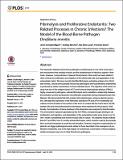Por favor, use este identificador para citar o enlazar a este item:
http://hdl.handle.net/10261/121101COMPARTIR / EXPORTAR:
 SHARE SHARE
 CORE
BASE CORE
BASE
|
|
| Visualizar otros formatos: MARC | Dublin Core | RDF | ORE | MODS | METS | DIDL | DATACITE | |

| Título: | Fibrinolysis and Proliferative Endarteritis: Two Related Processes in Chronic Infections? The Model of the Blood-Borne Pathogen Dirofilaria immitis |
Autor: | González Miguel, Javier CSIC ORCID ; Morchón, Rodrigo; Siles Lucas, Mar CSIC ORCID ; Simón Martín, Fernando | Fecha de publicación: | 2015 | Editor: | Public Library of Science | Citación: | PLoS ONE 10(4): e0124445 (2015) | Resumen: | The interaction between blood-borne pathogens and fibrinolysis is one of the most important mechanisms that mediate invasion and the establishment of infectious agents in their hosts. However, overproduction of plasmin (final product of the route) has been related in other contexts to proliferation and migration of the arterial wall cells and degradation of the extracellular matrix. We have recently identified fibrinolysis-activating antigens from Dirofilaria immitis, a blood-borne parasite whose key pathological event (proliferative endarteritis) is produced by similar mechanisms to those indicated above. The objective of this work is to study how two of this antigens [actin (ACT) and fructose-bisphosphate aldolase (FBAL)] highly conserved in pathogens, activate fibrinolysis and to establish a relationship between this activation and the development of proliferative endarteritis during cardiopulmonary dirofilariasis. We demonstrate that both proteins bind plasminogen, enhance plasmin generation, stimulate the expression of the fibrinolytic activators tPA and uPA in endothelial cell cultures and are located on the surface of the worm in contact with the host’s blood. ELISA, western blot and immunofluorescence techniques were employed for this purpose. Additionally, the implication of lysine residues in this interaction was analyzed by bioinformatics. The involvement of plasmin generated by the ACT/FBAL and plasminogen binding in cell proliferation and migration, and degradation of the extracellular matrix were shown in an “in vitro” model of endothelial and smooth muscle cells in culture. The obtained results indicate that ACT and FBAL from D. immitis activate fibrinolysis, which could be used by the parasite like a survival mechanism to avoid the clot formation. However, long-term overproduction of plasmin can trigger pathological events similar to those described in the emergence of proliferative endarteritis. Due to the high degree of evolutionary conservation of these antigens, similar processes may occur in other blood-borne pathogens. | Descripción: | 22 páginas, 12 figuras | Versión del editor: | http://dx.doi.org/10.1371/journal.pone.0124445 | URI: | http://hdl.handle.net/10261/121101 | DOI: | 10.1371/journal.pone.0124445 | E-ISSN: | 1932-6203 |
| Aparece en las colecciones: | (IRNASA) Artículos |
Ficheros en este ítem:
| Fichero | Descripción | Tamaño | Formato | |
|---|---|---|---|---|
| Fibrinolysis and Proliferative Endarteritis Two Related Processes in Chronic Infections The Model of the Blood-Borne Pathogen Dirofilaria immitis.pdf | Artículo principal | 3,51 MB | Adobe PDF |  Visualizar/Abrir |
CORE Recommender
PubMed Central
Citations
11
checked on 13-mar-2024
SCOPUSTM
Citations
21
checked on 17-abr-2024
WEB OF SCIENCETM
Citations
20
checked on 25-feb-2024
Page view(s)
339
checked on 18-abr-2024
Download(s)
188
checked on 18-abr-2024

